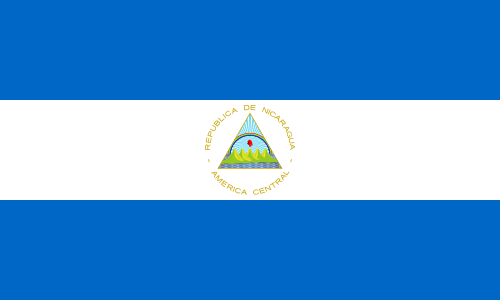Somoza family
The Somoza family (Spanish: Familia Somoza) was an autocratic family dictatorship in Nicaragua that lasted forty-three years, from 1936 to 1979.
Republic of Nicaragua República de Nicaragua | |||||||||
|---|---|---|---|---|---|---|---|---|---|
| 1936–1979 | |||||||||
.svg.png) | |||||||||
| Capital | Managua | ||||||||
| Common languages | Spanish | ||||||||
| Government | Military dictatorship | ||||||||
| President of Nicaragua | |||||||||
| Legislature | National Congress of Nicaragua | ||||||||
| Historical era | Interbellum, World War II, Cold War | ||||||||
| January 1 1936 | |||||||||
| 1960s | |||||||||
• Disestablished | July 17 1979 | ||||||||
| Currency | Nicaraguan córdoba | ||||||||
| ISO 3166 code | NI | ||||||||
| |||||||||
History
Anastasio Somoza García assumed the presidency after luring rebel leader Augusto César Sandino to peace talks, and murdering him soon afterwards. Somoza mended the Nicaraguan Constitution, concentrating power in his hands, and appointed his relatives and cronies to top government positions.[1] After Anastacio Somoza was assassinated in 1956, his two sons, Luis and Anastasio Somoza Debayle, ruled the country until 1976.[2]
Although Somoza and his two sons legally held the presidency for only 30 of those 43 years, they were the power behind other presidents in the intervening years. They continued to control the National Guard. The differences in the Somozas' ruling style, from father to son, reflected their adaptation to the U.S.-Latin American policy.[3] Their regime was overthrown in 1979 by the Sandinista National Liberation Front during the Nicaraguan Revolution. The family fled to the United States on July 17, 1979, ending a civil war that devastated Nicaragua's economy and claimed more than 130,000 casualties.[4]
For their more than four decades in power, the Somoza family accumulated wealth through corporate bribes, industrial monopolies, land grabbing, and foreign aid siphoning. By the 1970s, the family owned 23 percent of the land in Nicaragua. The foreign aid-funded project to rebuild the city of Managua, which was devastated by the earthquake on December 23, 1972, was never implemented as businesses were forced to relocate to land owned by the family.[5] The Somoza's wealth reached $533 million, which amounted to half of Nicaragua's debt and 33 percent of the country's 1979 GDP.[6]
Three of the Somozas served as President of Nicaragua. They were:
- Anastasio Somoza García (1896–1956; President 1937–1947, 1950–1956), the father.
- Luis Somoza Debayle (1922–1967, President 1956–1963), his legitimate eldest son.
- Anastasio Somoza Debayle (1925–1980, President 1967–1972, 1974–1979), his second legitimate son.
Other members of the Somoza family include:
- José R. Somoza, half-brother of Anastasio Somoza Debayle
- Hope Portocarrero, wife of Anastasio Somoza Debayle
- Lillian Somoza de Sevilla Sacasa, daughter of Anastasio Somoza García and Hope
- Isabel Urcuyo (1924–2014), wife of Luis Somoza Debayle[7]
- Anastasio Somoza Portocarrero, son of Anastasio Somoza Debayle and his wife
- Martha Debayle, niece of Anastasio Somoza Debayle, Nicaraguan-Mexican radio hostess and entrepreneur
References
- Newton, Michael (2014). Famous Assassinations in World History: An Encyclopedia [2 volumes]. Santa Barbara, CA: ABC-CLIO. p. 539. ISBN 9781610692854.
- Keen, Benjamin; Haynes, Keith A. (2009). A History of Latin America. Boston, MA: Houghton Mifflin Harcourt Publishing Company. p. 450. ISBN 978-0-618-78318-2.
- Keen, Benjamin; Haynes, Keith (2009). A History of Latin America, Eight Edition. Boston: Houghton Mifflin Harcourt Publishing Company. p. 450. ISBN 9780618783182.
- Hamilton, Lee H.; Inouye, Daniel K. (1987). Report of the Congressional Committees Investigating the Iran/Contra Affair. Washington, D.C.: DIANE Publishing. p. 25. ISBN 978-0-7881-2602-4.
- Clifford, Staten (2010). The History of Nicaragua. Santa Barbara, CA: ABC-CLIO. p. 77. ISBN 978-0-313-36038-1.
- Birdsall, Nancy; Williamson, John; Deese, Brian (2002). Delivering on Debt Relief: From IMF Gold to a New Aid Architecture. Washington, D.C.: Peterson Institute. pp. 134. ISBN 0881323314.
- "She's Mrs. Santa to the whole city". St. Louis Globe-Democrat. Managua. 25 December 1959. p. 43. Retrieved 21 January 2020 – via Newspapers.com.

.svg.png)